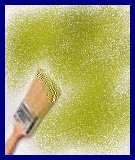Here are a few handy painting tips to keep in mind:
1. Water based primer works best with water based paint, and oil based primer works best with oil paint. Tinted primer is the best option to prepare the surface for a deep color. You may still need more than one coat, since going from light to dark usually requires at least two coats for even coverage. Without tinted primer, you may need more than two coats.
2. Some paints show lap marks (brush or roller marks created by overlapping strokes or touching up). This is usually indicated on the can, so be sure to read the label.
3. Use quality brushes and roller covers. They don’t necessarily have to be expensive, but natural bristles and fibers will create a much better finish than synthetics. Use the appropriate “nap” roller for the type of surface you are painting.
4. When sanding is required, always wipe away sand dust before priming, painting, stenciling, or staining.
5. Removing painter’s tape before the paint dries helps insure clean lines. Once the paint dries, removing the tape may also pull away some of the paint. Pull from the top down, in a diagonal line.

6. Neutral colors make the best backdrops when using multiple vibrant colors or large or multiple prints in a space. Neutrals keep the design from becoming overblown or chaotic, and they also accent interesting pieces because they do not compete with them.
7. Most paint colors dry darker than they appear in the paint can or they appear when they are first applied. Be aware of this fact and wait until paint has dried thoroughly before deciding if you need to apply another coat or simply touch up a few areas.
8. Spray paint works best in mild temperatures and when shaken thoroughly before use. Holding the can about 10″ from the object to be painted, and applying it lightly and evenly achieves the bests results.
9. Spray paint usually requires several light coats instead of one heavy coat, to avoid drips and to achieve a smooth, even finish.
10. Stain should be applied by moving in only one direction, with the grain of the wood, instead of using a back and forth motion as is utilized while painting.

